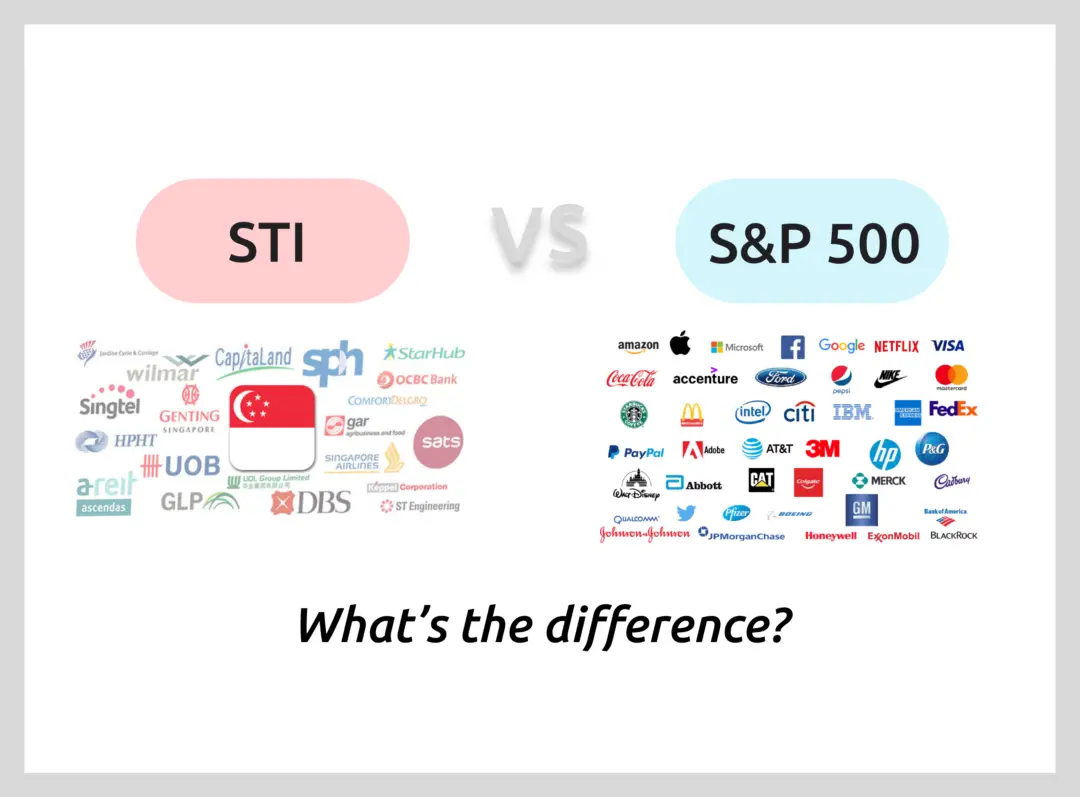With the S&P 500 being one of the most popular indexes out there, you may be wondering how Singapore’s very own Straits Times Index (STI) may fare against it.
What are the key differences between these two indices and which should you invest in?
Here is what you need to know to help you make a decision:
Contents
The difference between the S&P 500 and STI
The S&P 500 is an index that measures the performance of the top 500 companies in the US. In contrast, the STI tracks the performance of the top 30 companies listed on the Singapore Exchange (SGX). The indices differ in the type of markets they expose you to, with the S&P 500 providing you with greater diversification.
Here is an in-depth comparison between these 2 indices.
Country diversification
The S&P 500 includes US companies that fall under one of the 500 largest companies from the US that have a market capitalization of at least USD 11.8 billion.
On the other hand, the STI is also only exclusive to the top 30 companies which are trading on the SGX.
What does this mean for investors like you and me?
Due to the sheer size and nature of the companies in the S&P 500 like Apple or Amazon, the global influence and impact these US companies have are immense.
As such, growth and improvements in the global economy may be more beneficial to investors that choose to buy into the S&P 500.
Meanwhile, the SGX companies that are tracked by the STI are considerably more limited in terms of global influence.
Though companies like DBS and UOB have a greater reach across Asia, most of the companies in the STI have their impact limited just to Singapore.
However, this could be a boon as being limited just to Singapore will keep your investments safer from the volatility of the global economy. During the coronavirus selloff in March 2020, the S&P 500 fell by 35%, while the STI only fell by 25%.
Thus in terms of how widespread and influential these indices are, the S&P 500 comes out on top over the STI.
Despite this, investing in the STI could insulate your investments against global fluctuations.
Types of stocks
The S&P 500 contains the top 500 large-cap companies from the US while the STI contains the top 30 large and mid-cap companies in Singapore.
A large-cap company is one that has a market capitalisation of more than $10 billion.
Meanwhile, a mid-cap company has a market capitalisation between $2 to $10 billion.
Investopedia
The market cap of a company can be determined by multiplying the stock price by the number of outstanding shares.
The S&P 500 also has a bigger proportion of their portfolio tracking growth stocks. Meanwhile, the STI has a bigger proportion of tracking dividend stocks.
A growth stock is any share in a company that is anticipated to grow at a rate significantly above the average growth for the market.
Dividend stocks are companies that pay out regular dividends. Dividend stocks are usually well-established companies with a track record of distributing earnings back to shareholders.
Investopedia
As such, investing in the S&P 500 has greater growth potential with companies continually innovating and coming up with new ideas.
The STI on the other hand has more stocks that have already hit their maximum growth potential, and are not really innovating as much. They however do produce a greater dividend yield.
A dividend is the distribution of some of a company’s earnings to a class of its shareholders
Investopedia
As such, the index that you choose to track depends on whether you prefer dividend stocks or growth stocks.
Top Sectors
Here is a comparison between the top sectors that are found in the S&P500 and the STI as of 30th September 2021.
| S&P 500 | STI |
|---|---|
| Information Technology (IT) 27.5% | Financials 46.4% |
| Healthcare 13.3% | Real estate 22.7% |
| Consumer discretionary 12.4% | Industrials 9.5% |
| Financials 11.4% | Telecommunications 6.4% |
| Communication Services 11.2% | Consumer discretionary 6.3% |
The indices have a very different spread in their weightage.
The S&P 500 has its highest weightage of 27.5% in Information Technology (IT) while the STI has a whopping 46.4% in financials.
Technology has made business more efficient and cost-saving by leading the charge for innovations.
As such, it makes sense that the S&P 500 has IT as its biggest sector, as we’ve seen how much they have been able to grow in the past decade.
The STI on the other hand has financials taking up almost half of its weightage. With financials being a rather mature industry, it is a bit concerning to see the STI having such a large proportion of its weightage in it.
A mature industry is one that has passed both the emerging and growth phases of industry growth. Companies in these industries tend to be larger, older, and more stable.
Investopedia
So what is wrong with the STI having a large proportion of its weightage in mature industries?
- Even though it is more stable, the lack of innovation and chance to grow would mean that your investment would be more stagnant
- Any change to the financial industry as a whole would affect your portfolio greatly.
- Events that might cause people to stop borrowing or spending money such as recessions will pull your investments down
Overall, the S&P 500 is a lot more diversified than the STI, focusing more on growth stocks in the IT sector. In contrast, the STI is focused on more mature industries such as the financial and real estate sector.
Top holdings
Now, let us take a look at the top 5 holdings of each of the indices.
| S&P 500 | STI |
|---|---|
| Apple 6.1% | DBS Group Holding Ltd 18.56% |
| Microsoft 5.8% | Oversea-Chinese Banking Corporation Limited 13.73% |
| Amazon 3.9% | United Overseas Bank Ltd. (Singapore) 11.31% |
| Facebook Inc A 2.2% | Singapore Telecommunications Limited 6.37% |
| Alphabet Inc A (Google) 2.2% | Jardine Matheson Holdings Limited 4.90% |
The top 5 holdings of the S&P 500 are some of the biggest companies in the world, being household names all across the globe. They are all mostly part of the IT sector except for Amazon, which is in the consumer service sector.
As mentioned above, the STI has almost half of its weightage being dominated in the financial sector. What is even more surprising is that the top 3 out of all the 30 listed companies in the Singapore Exchange encompass that 46.4% in the financial sector.
This could pose a huge risk to your portfolio in the event Singapore’s financial sector or any of the big 3 banks collapse.
The overexposure to the financial sector will cause a huge hit to the STI and your investment!
You will need to take into consideration the exposure you would have in some of these companies and sectors if you were to decide to invest in either index.
Performance
With a clear uptrend and an average of 8-11% annual return, the S&P 500 heavily outperforms the STI, which tends to trade sideways without a clear net positive annual return.
If you were to purchase both indices 5 years ago, you would be up 98.9% for the S&P 500 (almost double your initial investment!).
The STI on the other hand, would have only returned a measly 6.4%.
To add to this, if we take a look at their all-time highs, the S&P 500 has constantly been hitting higher highs every year. Meanwhile, the STI has not hit its all-time high ever since 2008.
However, past performance does not indicate future returns, so it will be good to do your own research first, before investing in either index!
Availability of ETFs
You are unable to buy directly into either of these indices. Instead, you will need to buy into a fund that tracks this index.
2 types of funds that can track an index include exchange-traded funds (ETFs) and mutual funds.
The S&P 500 index is such a prominent index, so ETFs that track it are listed all over the world!
You are able to find an S&P 500 ETF listed on exchanges from many different countries:
- New York Stock Exchange (NYSE)
- London Stock Exchange (LSE)
- Australia Stock Exchange (ASX)
- Tokyo Stock Exchange (TSE)
- Singapore Exchange (SGX)
- Korea Stock Exchange (KRX)
Here are some of the ETFs that track the S&P 500:
| ETF Ticker | Exchange |
| S27 | SGX |
| VOO | NYSE |
| IVV | NYSE |
| SPY | NYSE |
| VUSA | LSE |
| VUSD | LSE |
| VUAA | LSE |
| SPX5 | LSE |
| CSPX | LSE |
| IUSA | LSE |
| IDUS | LSE |
There are many S&P 500 ETFs listed on the LSE as there are both accumulating and distributing ETFs.
Meanwhile, the STI is very limited in where you can find an ETF that tracks it.
It is exclusive only to the Singapore Exchange and only has 2 funds that track it:
- SPDR STI ETF (ES3)
- Nikko AM STI ETF (G3B)
You may want to check out our comparison between these 2 ETFs over here.
Verdict
Here is a comparison between the S&P 500 and the STI:
| S&P 500 | STI | |
| Type of stocks | Large-cap US equities | Large and mid-cap Singapore equities |
| Number of holdings | 505 | 30 |
| Top sectors | Information Technology (IT) 27.5% Healthcare 13.3% Consumer discretionary 12.4% Financials 11.4% Communication Services 11.2% | Financials 46.4% Real estate 22.7% Industrials 9.5% Telecommunications 6.4% Consumer discretionary 6.3% |
| Exposure to global economy | Greater | Weaker |
| Past performance | Stronger | Weaker |
| Availability of ETF | Wider | Weaker |
So which index should you choose to invest in?
Choose the S&P 500 if you are confident in the US economy
The S&P has historically been one of the best performing indices. Tracking the very best companies in the US, you are theoretically buying into the US economy as a whole.
The S&P 500 has survived and eventually climbed to all-time highs after every major crash in the past decade.
Thus, the S&P 500 is a rather safe way of buying into an already diversified portfolio.
With many of the S&P 500 companies having an impactful global influence as well, you can also buy into the S&P 500 if you are bullish on the global economy.
Despite this, you should take note that the S&P 500 is still very concentrated in just the US. You might want to consider other indices which are more diversified.
One such example is the MSCI World index, which contains many of the US companies listed in the S&P 500, but also companies from 22 other developed countries! You can take a look at our comparison between the MSCI World Index and the S&P 500 here.
Choose the STI if you prefer investing in more mature sectors such as financials and real estate
As the STI is heavily weighed in the financial and real estate sector, you can choose to buy into the STI if you believe these industries will flourish in the future.
The STI can also be argued to be a “safer” ETF due to being limited to Singapore. With most of the companies listed based only in Singapore, any volatile collapse of the global economy will not affect the STI as much. This will keep your investment insulated from global fluctuations.
Furthermore, the STI contains many companies that you are familiar with if you live in Singapore such as:
- Your local banks (DBS/OCBC/UOB)
- The malls you go to everyday (Capitaland/ Acendas)
- The airlines you take to travel (Singapore Airlines)
If you are confident in these companies which you are familiar with and believe that they will continue to do well as Singapore’s economy grows, this could be a good reason for you to choose to invest in the STI as well.
Conclusion
Both indices allow you to purchase into the top companies of either Singapore or the US. The main considerations you should have include:
- If you are more confident in the US or Singapore economy
- What sectors you believe will flourish in the future
- The risk appetite you have for a higher or lower volatility index

Do you like the content on this blog?
To receive the latest updates, you can follow us on our Telegram channels (Personal Finance or Crypto) and Facebook.
Are you passionate about personal finance and want to earn some flexible income?





